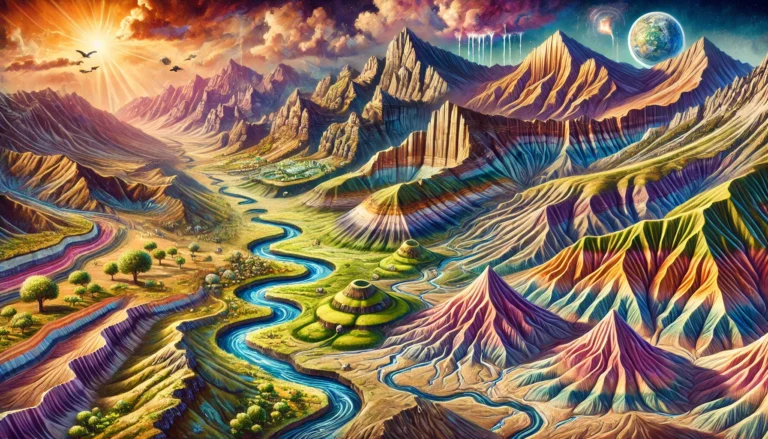Aryan Rock System
We now arrive at the Aryan Rock System, the final and most recent layer in India’s geological past, spanning from the Upper Carboniferous (~300 million years ago) to the Present.
This period witnessed massive coal formation, marine invasions, volcanic eruptions, and the birth of the Himalayas. The Aryan Rock System is divided into four major geological formations:
1️⃣ Gondwana System (The Coal-Bearing Treasure)
2️⃣ Jurassic System (The Shallow Seas of the Past)
3️⃣ Deccan Trap (The Great Volcanic Outburst)
4️⃣ Tertiary System (The Rise of the Himalayas)

Gondwana System
The Gondwana System derives its name from the Gonds, a tribal group of Telangana and Andhra Pradesh. This system holds nearly 98% of India’s coal reserves and played a crucial role in shaping India’s industrial progress.
📍 Formation
- Gondwana rocks were deposited in synclinal troughs (deep depressions in ancient plateaus).
- As more sediments accumulated, the troughs subsided, forming lakes and swamps.
- Freshwater environments allowed plants and animals to thrive, leading to coal formation over millions of years.
- The process began in the Permian period (~250 million years ago).
📍 Gondwana Coal: The Backbone of India’s Energy Sector
- 98% of India’s coal comes from Gondwana deposits.
- Unlike Carboniferous coal (which is older and richer in carbon) found in the USA and Europe, Gondwana coal is younger and has lower carbon content.
- Other important minerals include iron ore, copper, uranium, and antimony.
- Sandstones, slates, and conglomerates from this system are widely used as building materials.
💡 Did You Know?
The Damodar Valley (Jharkhand & West Bengal), Son Valley (Madhya Pradesh), and Godavari Valley (Andhra Pradesh) hold India’s richest Gondwana coal deposits.

Jurassic System
The Jurassic period (~200–145 million years ago) was marked by a major marine transgression (when seas advance over land).
📍 Formation
- Shallow seas covered parts of Rajasthan and Kutch, leading to thick limestone, sandstone, and shale deposits.
- Another marine invasion occurred on the east coast between Guntur and Rajahmundry.
- These deposits are rich in fossils, helping paleontologists study ancient marine life.
Deccan Trap
Imagine a time when volcanic lava flowed endlessly, covering almost half of India. This was the Deccan Trap, a massive volcanic eruption that started at the end of the Cretaceous period (~66 million years ago) and lasted into the Eocene (~56 million years ago).

📍 Formation & Spread
- Fissure eruptions (lava flowing from cracks in the Earth) covered 10 lakh km² (almost one-third of India’s landmass).
- Today, it covers 5 lakh km² in Maharashtra, Gujarat, Madhya Pradesh, and northern Karnataka.
- The lava solidified into basalt, forming step-like plateaus (hence the term “Trap,” from the Swedish word for “stair”).
📍 Significance
- Black Cotton Soil (Regur Soil): The weathering of basaltic rocks over millions of years led to the formation of black soil, ideal for cotton cultivation.
- Inter-Trappean Beds: Between volcanic eruptions, sediment layers accumulated, creating beds rich in fossils and minerals.
The Three Layers of the Deccan Trap
| Trap Layer | Location | Inter-Trappean Beds (Sediments Between Lava Flows) | Volcanic Ash Layers |
| Upper Trap | Maharashtra, Saurashtra | Present | Present |
| Middle Trap | Central India, Malwa Plateau | Rare to Absent | Present |
| Lower Trap | Madhya Pradesh | Present | Rare to Absent |
💡 Did You Know?: Some scientists believe the Deccan Traps contributed to the extinction of dinosaurs by releasing massive amounts of volcanic gases, disrupting Earth’s climate. 🌋🦖
Tertiary System: The Birth of the Himalayas
The Tertiary period (~60 to 7 million years ago) is perhaps the most crucial chapter in India’s geological history—it is when the Himalayas were born!
📍 Formation
- Before this period, India was an island moving northward.
- Around 50 million years ago, the Indian Plate collided with the Eurasian Plate, pushing up massive rock formations, leading to the formation of the Himalayas.
- The collision is still ongoing, which is why the Himalayas are rising every year by a few millimeters!
📍 Significance
- The Himalayan rivers (Ganga, Indus, Brahmaputra) originated during this period.
- Many petroleum and natural gas reserves in India (like Assam and Gujarat) were formed.
💡 Did You Know?
The Himalayas are made up of three different rock types:
- Tibetan Zone (Tethys Himalayas) – Made of marine fossils from the time when an ocean (Tethys Sea) existed between India and Eurasia.
- Lesser Himalayas – Formed from old metamorphic rocks.
- Siwaliks (Outer Himalayas) – Composed of younger sedimentary rocks from eroded material.
Conclusion
From the coal-rich Gondwana valleys to the volcanic plains of the Deccan, from the fossil-rich Jurassic sediments to the rising peaks of the Himalayas, the Aryan Rock System is a living chronicle of India’s past.
Understanding these rock systems isn’t just about studying stones—it’s about unraveling India’s economic potential (coal, petroleum, minerals), agricultural richness (black cotton soil), and natural history (Himalayan formation).
So, the next time you step on black cotton soil, climb a Himalayan peak, or hear about coal mining, remember—you are walking on a piece of India’s 4-billion-year-old geological legacy! 🌍⛰️🚀





